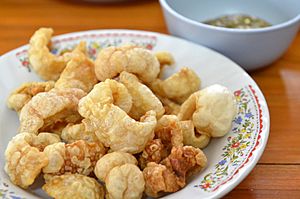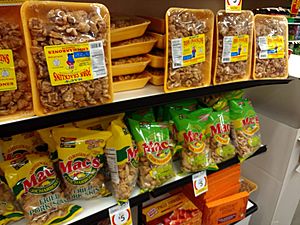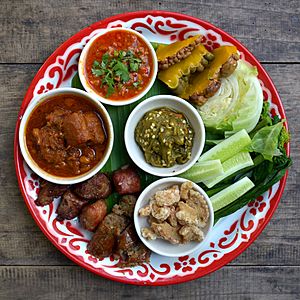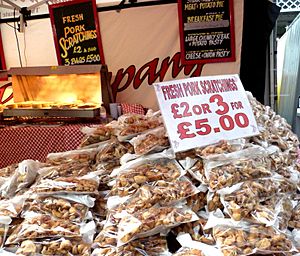Pork rind facts for kids

uncooked pork belly with rind attached
|
|
| Type | Cooking and baking staple |
|---|---|
| Main ingredients | Pig skin |
Pork rind is simply the skin of a pig. People use it in many different ways around the world.
When pig skin is cooked, it can become a crispy snack. This happens by frying it in fat or roasting it. These crispy pieces are often called cracklings or scratchings. Frying helps remove a lot of the fat, making the pieces smaller and crunchy.
Contents
How Pork Rind Becomes a Snack
Pork rind is often a leftover from making lard, which is melted pig fat. It's also a clever way to make the tough pig skin tasty to eat. Long ago, animal fats were the main way people got oil for cooking. They were a big part of many diets before factories started making vegetable oils cheaper and easier to find.
You can buy pork rinds that you cook in a microwave, just like popcorn. You can eat them warm. There are also pickled pork rinds, which are often eaten cold from the fridge. Unlike the crispy fried ones, pickled pork rinds are soft and rich.
How Pork Rind is Made
For making lots of pork rinds to sell, factories use frozen, dried pig skin pieces. First, they add water and flavor to these pieces. Then, they fry them in pork fat at very high temperatures (about 200-210 degrees Celsius). As they cook, the rinds puff up and float on the oil. After cooking, they are taken out, flavored, and air-dried. Sometimes, special ingredients are added to keep them fresh longer.
Pork Rind Around the World
Pork rinds are enjoyed in many countries, often with different names and ways of preparing them.
Americas
Brazil
In Brazil, this snack is called Torresmo. It's usually served in small pieces. It's also a common side dish for meals like feijoada.
Colombia
In Colombia, pork rinds are known as Chicharrones. There are two main types. Chicharrón toteado is light and crispy, with no meat. Chicharrón cocho has some meat still attached to the skin, making it crispy on the outside and juicy inside. It's often served with beans, rice, fried eggs, avocado, and plantain as part of a famous dish called bandeja paisa.
Canada
In Newfoundland, small fried pieces of pork rind are called Scrunchions. They are used to add flavor to other foods, like salt fish and potatoes. In Quebec, they are called oreilles de Christ (Christ's ears) and are eaten at traditional sugar shack meals.
Mexico
Mexico is one of the biggest producers and eaters of pork rinds, known as chicharrones. Sometimes, they still have fat attached, which is called chicharrón con manteca.
People often eat chicharrones at home in Mexico. They can be served in a soup with chili sauce, or as an appetizer. You can also buy them from street vendors, usually with hot sauce and lime juice. A popular breakfast is salsa de chicharron, which is pork rind cooked in a green tomato or tomato sauce. If the liquid is drained, the pork rind can be used in tacos.
When frying rinds, small pieces break off. These are collected and used to make a thick, fatty sauce. Another product from frying rinds is lard.
Cueritos are also pig skin, but they are soft and chewy, not crispy. They are not cooked as much as chicharrón. You can find them easily in Mexico as Mexican street food, often sold by butchers. They might be served fresh or marinated in vinegar with onion, lemon, salt, and chili powder.
Another type is duritos, also called chicharrones de harina. These are made from fried flour, not pig skin, and often have a pinwheel shape. They are popular with street vendors.
In the Yucatán region, pork rind is often served with pork belly, blood sausage, and a spicy sausage made from pork entrails.
United States
In the United States, pork rinds is the name for fried or roasted pig skins. Pieces of fried meat, skin, or fat left over from making lard are also called cracklings. Cracklings are usually roasted or fried pork rind with salt rubbed in.
Cajun cracklings from Cajun cuisine are fried pieces of pork fat with a little skin, flavored with spicy Cajun seasonings.
Pork rinds sold in bags are made in two steps: the pig skin is first cooked and dried, then fried until it puffs up. These are also called chicharrón, a Spanish word.
Sometimes, pork rinds in the U.S. have a pink or purple spot. These are harmless USDA stamps that show the skin has been inspected.
Former President George H.W. Bush really liked pork rinds. When he said he enjoyed them in 1988, sales went up a lot!
Asia
China
Zhīzhā (脂渣) is a very popular snack in Qingdao, Shandong. It's a byproduct of making lard. While lard is inexpensive, zhīzhā can be quite valuable.
- Jīngròu zhīzhā (精肉脂渣) – This is made from skin that is removed and sliced very thin. After the fat is taken out, the rest is hard and tastes like a salty cracker, seasoned with salt.
- Huāzhī (花脂) – This is made from intestines, chopped and deep-fried twice. It's used in stews or soups.
Philippines
Chicharon (Chicharon) is often bought from vendors as pulutan (snacks eaten with drinks). You can also find it in stores and markets. It's made by deep-frying dried pork rinds and adding salt. People usually eat it with vinegar, spicy vinegar, or other sauces like bagoong or lechon liver sauce. There are also chicharong manok (chicken skin) and chicharong bulaklak (pig intestine). It's also used as a topping for noodle dishes like pancit palabok and in preparing pork sisig.
Thailand
Khæbh̄mū, or khaep mu, (Thai: แคบหมู) are crispy pork rinds from Thai cuisine. They are a special food from Chiang Mai in northern Thailand. One way to make khaep mu is to first cure the pork skin with salt for several days. Then, it's soaked in water to help the fat cells expand, which makes the skin puff up when cooked. The pork is then slowly cooked in fat, usually lard. After this, the pork can be stored. The pork is then cut into smaller pieces and baked until it's perfectly crispy.
Another way is to salt the skin, dry it in the sun, slice it, and deep-fry it twice. A third way is to cut the skin into strips, boil them, dry them well, and then deep-fry them.
People in northern Thailand often eat pork rinds with different chili pastes, like nam phrik num (made with green chili peppers) and nam phrik ong (made with dried chili peppers, tomato, and minced pork). It can also be eaten as a snack on its own, or with a dipping sauce made from lime juice and chili. It's also a side dish for Thai meals like Nam ngiao and the famous Thai salad som tam. Sometimes, it's crushed and used as an ingredient in dishes like sa makhuea, a northern Thai salad.
Vietnam
Pork rinds used to be a very common food in Vietnam before 1986. Back then, cooking oil and meat were hard to get, so fat liquid and pork rind were important replacements in daily meals. Today, with a better economy, pork rind is no longer just a substitute. Instead, it's a special part of many Vietnamese dishes, like cơm tấm (broken rice), noodle and snails (bún ốc), and noodle soup. In Vietnamese, pork rind is called tóp mỡ.
Europe
In many Slavic countries, pork rinds are known by names like škvarky (in the Czech Republic and Slovakia) or škvarok (in Russia or Ukraine). They are often mixed with lard to make a spread and served with bread. This is especially popular during celebrations.
In Lithuania and Latvia, they are mixed with boiled peas and eaten as a snack. This dish is called žirniai su spirgučiais in Lithuanian and zirņi ar speķi in Latvian. They are also usually served with Lithuanian cepelinai (potato dumplings).
They are part of a traditional Czech dish called bramborové knedlíky se škvarkama a kyselým zelím, which is potato dumplings with cracklings and sauerkraut.
In Hungary, cracklings – tepertő – can be made from pork or goose skin. They are usually served with salt and bread, sometimes with vegetables. They are most popular when pigs are slaughtered, as the pork rind is freshest then. They are often eaten for breakfast or dinner. A type of biscuit, tepertős pogácsa, is also made with cracklings.
In Romania, they are called jumări. The outer layer of a pig's skin is usually served with salt and cut into thin slices.
In Spain, they are called chicharrones. They became very famous in South America after being brought there. In Catalonia (Spain), a llardó is a piece of fried animal fat that remains after pressing to get lard. They are golden and crunchy. They are sold in shops and are essential for making coca de llardons, a cake eaten during festivals.
Flæskesvær is a traditional snack in Danish cuisine, served cold and dried.
United Kingdom
Pork scratchings is the British name for deep-fried, salted, crunchy pork rind with fat still attached. They are eaten cold. Pork scratchings are usually heavy and hard, with a crispy layer of fat under the skin, and only flavored with salt. The pig hair is usually removed by quickly burning the skin before it's cut and cooked.
Crackling is different. It's cut from a freshly roasted piece of pork (like a Pork loin) after it's cooked. It's usually served warm or hot, before the fat under the skin cools down.
Pork scratchings are sold as a snack food in many brands. Unlike the large, light bags of pork rind without fat found elsewhere, in the UK they are sold in smaller bags. They are often eaten with a pint of beer in a pub, like crisps or peanuts. You can also buy them from butchers, supermarkets, or newsagents. They have even been taken to the North Pole and South Pole on trips because they provide a lot of energy.
There are three main types. Traditional scratchings are made from shank rind and cooked once. Pork crackling is made from shoulder rind and fried twice. It's first cooked at a low heat, then at a higher temperature to be less fatty and crispier. A newer type is pork crunch, made from back rind and double-fried to be a large, puffy snack. Some stores sell raw skin and fat for you to cook at home, or cooked ones ready to eat. The word "crackling" is also used for a twice-cooked version of pork scratchings.
Images for kids






